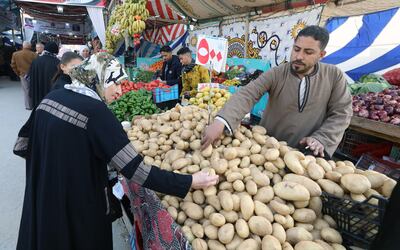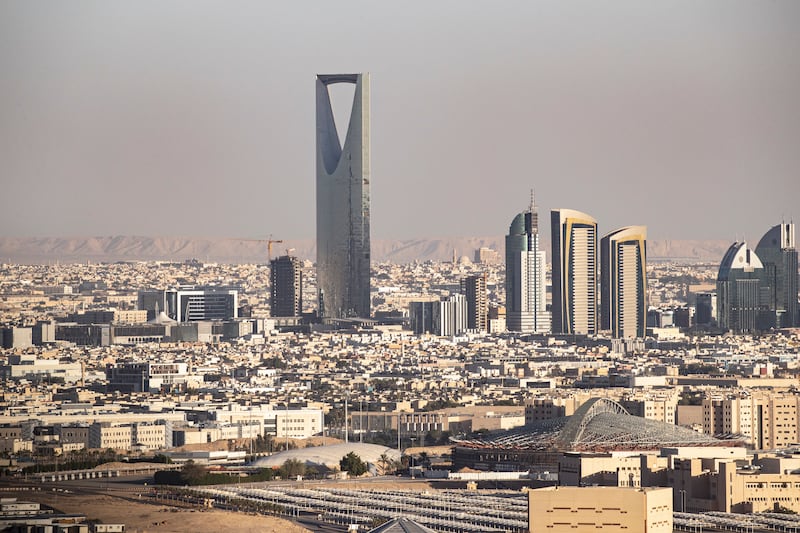Arab economies are expected to grow 5 per cent in 2022, driven by higher oil prices and production as well as due to an extension of government support that was provided to help economies recover from the coronavirus pandemic, according to the latest report from the Arab Monetary Fund.
Oil-exporting countries in the Arab world will expand 5.6 per cent this year, supported by 5.8 per cent growth in the GCC region. Meanwhile oil-importing countries are expected to record a moderate growth of 3.7 per cent “due to the challenges imposed by the global economic environment”, the Abu Dhabi-based AMF said in its Arab Economic Outlook report.
“The growth rate of Arab economies is expected to rise ... supported by the increase in oil production and its prices in international markets and the continuation of stimulus packages adopted in Arab countries whose accumulated value reached $396 billion during the period (2020-2022),” the AMF said.
In 2023, however, the growth is expected to drop to 4 per cent “due to the decline in global demand, the gradual withdrawal of stimulus packages, and the anticipated fall in commodity prices”, the fund said.
Oil prices continued to trade higher amid Russia-Ukraine conflict. Brent is up more than 30 per cent since the start of this year after falling from a 14-year high when the benchmark nearly touched $140 per barrel last month.
Governments across the Arab world are also supporting their economies with stimulus packages. The UAE, the region’s second-largest economy, introduced an economic stimulus worth Dh388bn to offset the impact of the pandemic, which tipped the world economy into its worst recession since the 1930s. That includes the central bank’s Dh50bn Targeted Economic Support Scheme to boost liquidity in the financial and banking sector and other measures.
Saudi Arabia, the biggest Arab economy, launched fiscal and monetary support packages in 2020 to soften the impact of the pandemic on its economy. The relief measures were aimed at protecting banks and businesses, especially micro, small and medium-sized enterprises, during the global economic slowdown.
In June 2020, the Saudi Central Bank injected 50bn riyals ($13.33bn) into its banking sector to boost liquidity and the lending capacity of financial institutions. It provided another 50bn riyals to shore up its private sector and launched concessionary finance for SMEs of up to 13.2bn riyals and loan guarantees worth 6bn riyals.
GCC countries’ growth rate of 5.8 per cent this year, up from 3.1 per cent last year, will be supported by a number of factors “that will stimulate the output of both oil and non-oil sector”, it said. These include the positive momentum of economic reforms to diversify the economy and the positive impact of the stimulus packages to support recovery from the Covid-19 pandemic.
The UAE and other GCC countries have introduced reforms to attract foreign direct investment in the past two years. Last year, the UAE, unveiled a new industrial strategy to boost the contribution of the industrial sector to Dh300 billion ($81.68bn) in the next 10 years from Dh133bn.
The country also overhauled its commercial companies’ law in 2020 to attract more foreign capital and annulled the requirement for onshore companies to have an Emirati shareholder.
Other Arab oil-exporting countries are also expected to benefit from the planned increases in oil production volumes within the framework of the Opec+ agreement and the rise in the global oil and gas prices, bringing the group’s growth rate to 4.6 per cent in 2022, compared with 3.3 per cent in 2021, the AMF said.
Opec+ member countries, led by Saudi Arabia and Russia, are boosting oil supplies in the market every month as global economies recover from the pandemic. The group will add another 432,000 barrels per day of crude to the market in May, it said last month.

The growth rate among other Arab oil-exporting countries, however, is expected to decline to 3.9 per cent next year “due to the internal conditions that impact growth and the challenges facing this group of countries in terms of supporting business environments and increasing its attractiveness”.
Arab oil-importing countries, on the other hand, are expected to record a significant improvement in the growth rate next year at 5 per cent, on the back of aggregate demand and a gradual easing of pressures facing public budgets and balances of payments as a result of the expected decline in commodity prices next year.
The inflation in Arab counties is expected to rise to 7.5 per cent in 2022, compared with 5.7 per cent in 2021, while a relative decline in the inflation rate is expected in 2023 to reach 7.0 per cent “reflecting challenges facing global supply chains and the increase in the prices of agricultural, industrial and energy products”, the AMF said.
Inflation is rising around the globe amid higher oil prices and the conflict between Russia and Ukraine. Russia is a major supplier of oil, gas and metals, and, together with Ukraine, of wheat and corn. A supply crunch of these commodities has already driven prices up sharply.
The tightening of monetary policy will dominate in many Arab countries over the forecast horizon “to maintain the stability of exchange rate regimes and curb inflationary pressures”, the fund said.
The consolidated public budget deficit of Arab countries as a group is expected to decrease to reach 2.4 per cent of GDP in 2022 due to the anticipated increase in oil revenue, and the achieved surplus in the GCC public budget for the first time since 2014.
The Arab countries will also record a current account surplus this year at $186.6bn, equivalent to about 6.4 per cent of the GDP, due to the increase in export receipts and interest income, according to the AMF.







